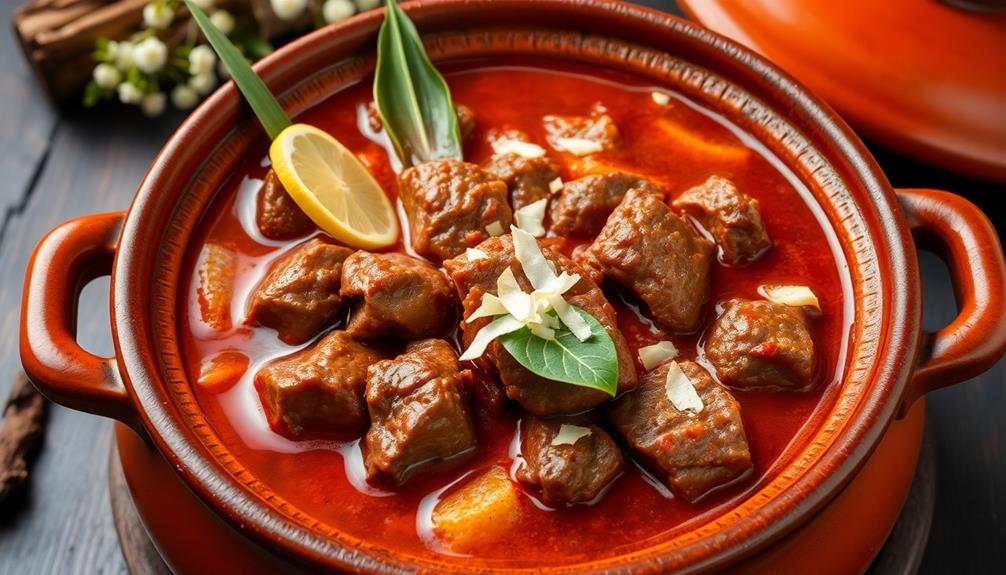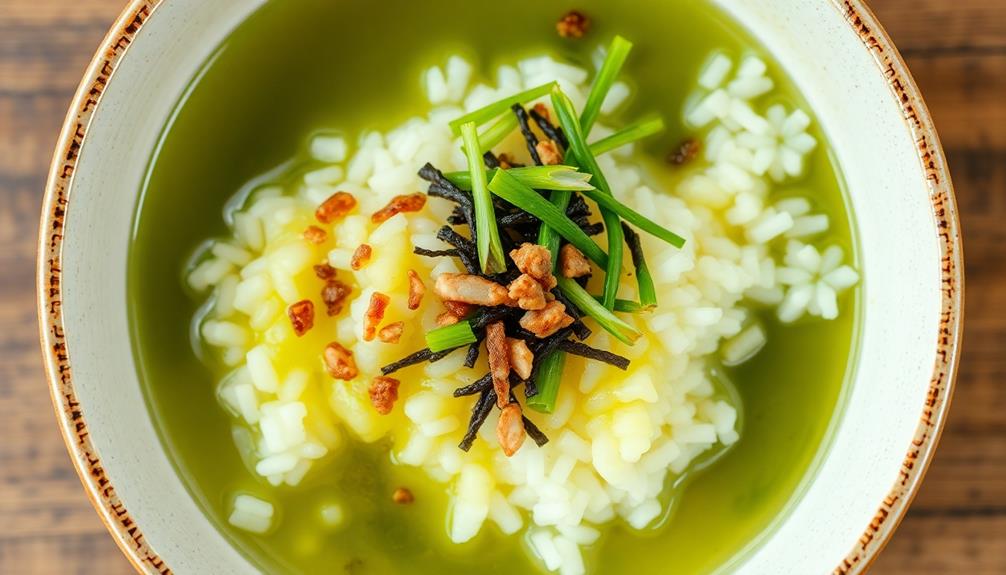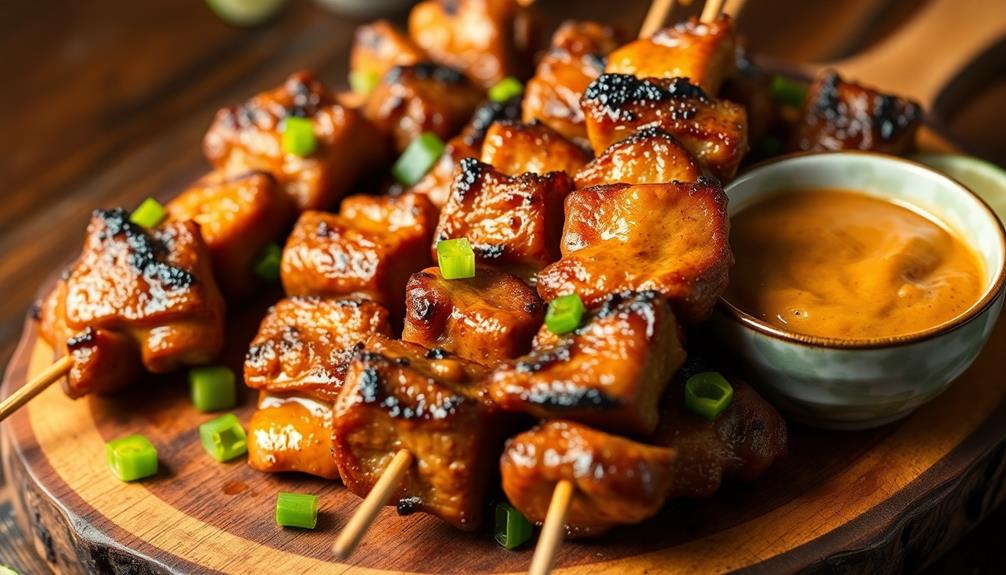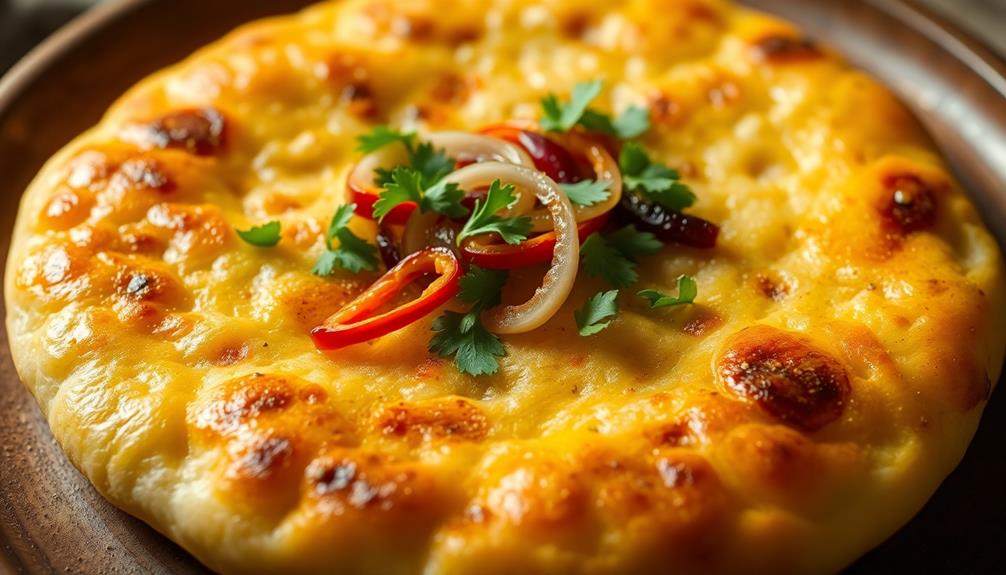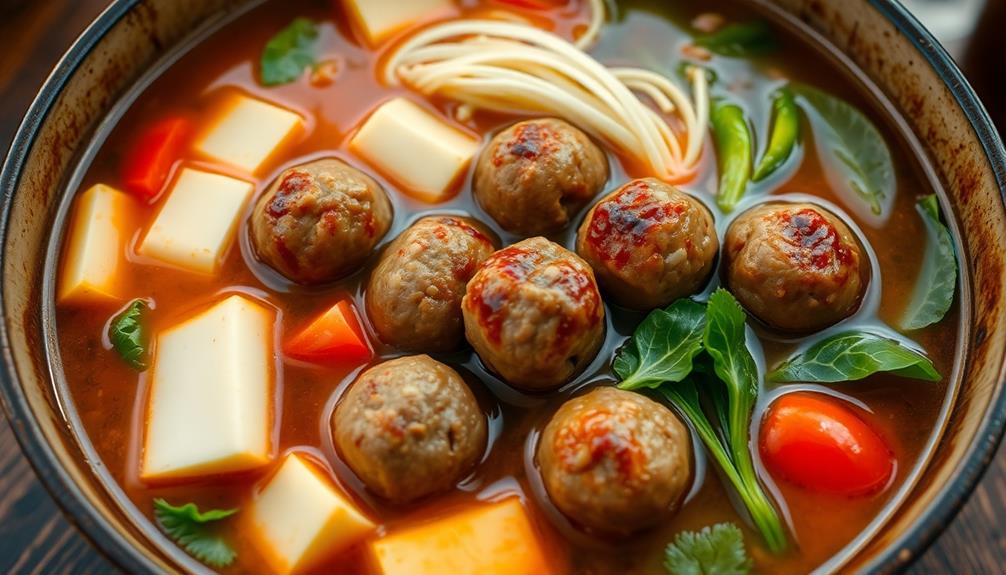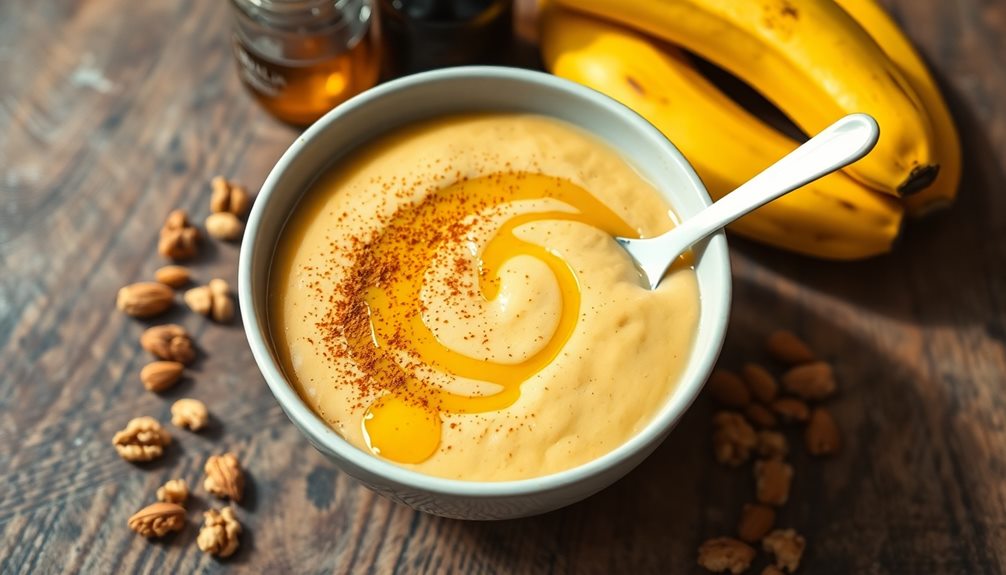Beef rendang is an incredible Indonesian curry dish that'll transport your tastebuds on a flavorful journey. It's got origins in West Sumatra, where the name 'rendang' comes from the Malay word for slowly simmering. This iconic meal features tender beef simmered in a rich, creamy coconut milk sauce that's bursting with aromatic spices. The complex blend of flavors – from the savory depth of the meat to the balanced heat and sweetness – creates an unforgettable dining experience. And if you're curious to learn more about this culinary masterpiece, just keep reading!
Key Takeaways
- Beef rendang is a rich, flavorful Indonesian curry dish known for its complex spice blend and slow cooking method.
- It originates from the Minangkabau region of West Sumatra and is a symbol of Indonesian culinary tradition.
- The dish is recognized for its unique flavor profile, balancing the heat from spices and the sweetness from coconut milk.
- The long simmering process allows the spices to thoroughly infuse the tender beef, resulting in a thick, glossy sauce.
- Beef rendang is often served with steamed rice and paired with pickled vegetables or sambal for a complete dining experience.
History
Beef rendang traces its origins back to the Minangkabau region of West Sumatra, Indonesia. This delicious dish has been a beloved part of the local cuisine for centuries, passed down through generations.
The name "rendang" comes from the Malay word "merandang," which means to simmer or cook slowly. This cooking method is key to the dish's signature rich, complex flavors.
The traditional rendang recipe calls for beef that's been simmered in a spice-filled coconut milk mixture for hours on end. As the meat slowly cooks, it absorbs all the wonderful aromas and becomes incredibly tender.
The blend of spices, including chili peppers, garlic, ginger, and lemongrass, creates a mouthwatering balance of heat, sweetness, and tanginess.
Over time, rendang has become a beloved dish across Indonesia and has even gained popularity worldwide. Its unique taste and cultural significance make it a true culinary treasure.
Recipe
Beef Rendang is a rich, flavorful Indonesian curry dish that originates from the Minangkabau region. This dish is known for its complex blend of spices and the way the beef is slowly simmered until it becomes incredibly tender and infused with the aromatic flavors. Beef rendang is often prepared for special occasions and celebrations, and every family has their own traditional rendang recipe that has been passed down through generations. The dish is traditionally served with steamed rice or lemang, a type of glutinous rice cake cooked in bamboo. Some variations of rendang also include ingredients such as coconut milk, lemongrass, galangal, and turmeric, adding to the depth and complexity of its flavors.
Rendang is traditionally made by simmering the beef in a mixture of coconut milk and a fragrant spice paste for several hours, allowing the flavors to meld and the beef to become meltingly soft. The long cooking process also allows the sauce to reduce and thicken, creating a wonderfully concentrated and intense flavor.
Ingredients:
- 2 lbs beef chuck or brisket, cut into 1-inch cubes
- 2 cups coconut milk
- 4 cloves garlic, minced
- 2 shallots, sliced
- 3 lemongrass stalks, bruised
- 2 kaffir lime leaves
- 2 inch piece of ginger, peeled and sliced
- 2 teaspoons ground coriander
- 1 teaspoon ground cumin
- 1 teaspoon ground turmeric
- 1 teaspoon ground chili powder
- 1 teaspoon salt
- 1/2 teaspoon ground black pepper
Instructions:
In a large pot or Dutch oven, combine the beef, coconut milk, garlic, shallots, lemongrass, lime leaves, ginger, coriander, cumin, turmeric, chili powder, salt, and pepper.
Bring the mixture to a boil, then reduce the heat to low, cover, and simmer for 2-3 hours, stirring occasionally, until the beef is very tender and the sauce has thickened.
For best results, let the rendang cool completely, then reheat it gently before serving. This allows the flavors to meld even further.
Serve the beef rendang with steamed rice, cucumber salad, and perhaps a sprinkle of fried shallots or toasted coconut on top. Enjoy the rich, complex flavors of this authentic Indonesian dish.
Cooking Steps
First, you'll toast the spices to bring out their amazing flavors.
Then, you'll add creamy coconut milk and let the beef simmer until it's meltingly tender.
Step 1. Toast the Spices
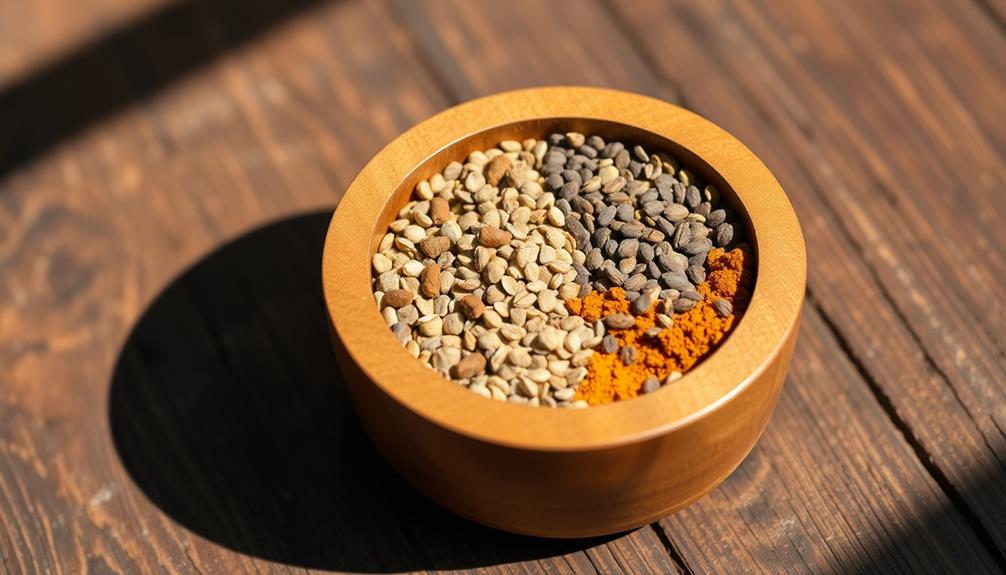
To begin the process, you'll want to toast the spices. This simple step brings out the deep, complex flavors that make beef rendang so delicious.
Grab a dry skillet and place it over medium-high heat. Add the coriander, cumin, cloves, and cardamom. Toast the spices, stirring frequently, until they become fragrant and slightly darker in color. This should take about 2-3 minutes.
Be careful not to let them burn, as that can make the flavors bitter.
Once the spices are toasted, transfer them to a mortar and pestle or a spice grinder. Grind the spices into a fine powder. This step ensures the spices will blend seamlessly into the dish, infusing every bite with their warm, earthy notes.
With the spices prepped, you're ready to move on to the next stage of creating your authentic beef rendang.
Step 2. Add Coconut Milk

Next, you'll add the coconut milk to the pot. This will bring a rich, creamy texture to the rendang. Pour in the full-fat coconut milk, stirring it gently to incorporate it with the toasted spices.
As the coconut milk simmers, it will meld with the flavors, creating a luscious sauce. Be sure to keep an eye on the pot, adjusting the heat as needed to maintain a gentle simmer. The coconut milk will gradually thicken, coating the beef pieces.
This process takes time, so be patient. Keep stirring occasionally to prevent the sauce from sticking or burning. The coconut milk will transform the dish, infusing it with a luxurious creaminess that balances the bold spices.
Soon, your kitchen will be filled with the intoxicating aroma of the simmering rendang.
Step 3. Simmer Until Beef Is Tender

With the coconut milk now incorporated, it's time to simmer the rendang until the beef is meltingly tender. This low and slow cooking process is key to developing the rich, complex flavors of this iconic dish.
Gently lower the heat and let the pot simmer, stirring occasionally, for 60-90 minutes. As the minutes tick by, the beef will become more and more tender, practically falling apart with the gentlest of forks.
Be patient – this is no quick recipe. The long, steady simmering allows the spices to fully infuse the meat, tenderizing it to perfection.
You'll know it's ready when the beef is incredibly soft and the sauce has thickened to a glossy, coating consistency. The rendang should have a deep, burnished color and an aroma that fills the kitchen, making your mouth water.
Once the beef reaches this melt-in-your-mouth stage, it's time to move on to the final steps of the recipe.
Step 4. Add Lime Leaves

Now that the beef has simmered to tender perfection, it's time to add the aromatic lime leaves. These fragrant, green leaves will infuse the rendang with a bright, citrusy aroma that'll make your mouth water.
Gently drop the lime leaves into the simmering pot and let them mingle with the richly spiced beef. As the leaves release their oils, they'll add a lovely depth of flavor to the dish.
Be sure to stir the pot occasionally, allowing the lime leaves to meld with the other ingredients. Their distinct flavor will permeate the rendang, balancing the heat and creating a truly harmonious blend of tastes.
The lime leaves will also help to tenderize the beef even further, ensuring each bite is melt-in-your-mouth delicious.
Once the lime leaves have had a chance to work their magic, you can move on to the next step. Get ready to experience the incredible flavors that are about to unfold!
Step 5. Reduce Liquid Until Thickened

As the lime leaves have infused the rendang with their bright, citrusy aroma, it's time to focus on reducing the liquid until the dish reaches the desired thick, luscious consistency.
Bring the simmering pot back to a gentle boil, then reduce the heat to maintain a steady simmer. This step is crucial, as you'll need to keep a close eye on the pot, stirring occasionally, until the liquid has reduced by about half.
The goal is to achieve a rich, velvety texture that coats the beef beautifully. As the liquid simmers away, the flavors will concentrate, creating a deeply satisfying rendang.
Be patient and resist the urge to rush this process – the slow reduction is what gives the dish its signature luxurious mouthfeel. Keep tasting and adjusting the seasoning as needed, adding a touch more salt or sugar to balance the flavors.
When the rendang reaches the perfect thick, clingy consistency, you'll know it's time to move on to the next step.
Final Thoughts
Beef rendang is a dish that has captivated the hearts and palates of many. It's a true culinary masterpiece that deserves all the praise it receives.
The final step of reducing the liquid until it's thick and glossy is the crowning achievement. As the sauce thickens, it transforms into a rich, velvety coating that clings to the tender beef. The aroma alone is enough to make your mouth water.
Once you've achieved that perfect consistency, you'll know you've done the dish justice. Serve it alongside fluffy white rice, and you have a meal fit for a king.
The balance of flavors is simply divine – the heat from the spices, the sweetness of the coconut milk, and the savory depth of the beef all come together in harmony.
Beef rendang is a true celebration of Indonesian cuisine. Savor every bite, and you'll be transported to the vibrant flavors of the islands.
Frequently Asked Questions
What Is the Best Cut of Beef for Beef Rendang?
The best cut of beef for this dish is chuck or shoulder. They're flavorful, tough cuts that become meltingly tender when simmered for hours. You'll get the perfect texture and depth of flavor you're looking for.
How Long Can Beef Rendang Be Stored?
Properly stored, beef rendang can last up to a week in the fridge or several months in the freezer. For best quality, consume within 3-5 days refrigerated or 2-3 months frozen.
Can Beef Rendang Be Frozen?
Yes, you can freeze beef rendang. It freezes well and can be stored in the freezer for up to 3 months. Just make sure to let it thaw completely before reheating and serving.
Is Beef Rendang Spicy?
Yes, beef rendang can be quite spicy. The dish typically features a blend of warm, aromatic spices that can create a fiery and intense flavor profile. However, the level of heat can be adjusted to your preference.
What Can Be Served With Beef Rendang?
To accompany the savory and flavorful dish, you can serve it with steamed rice, roti, or nasi goreng. Complementary sides like a fresh vegetable salad or pickle can also enhance the overall dining experience.
